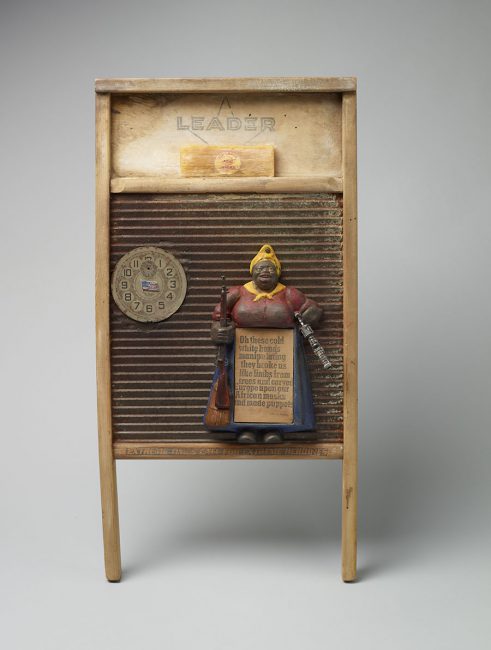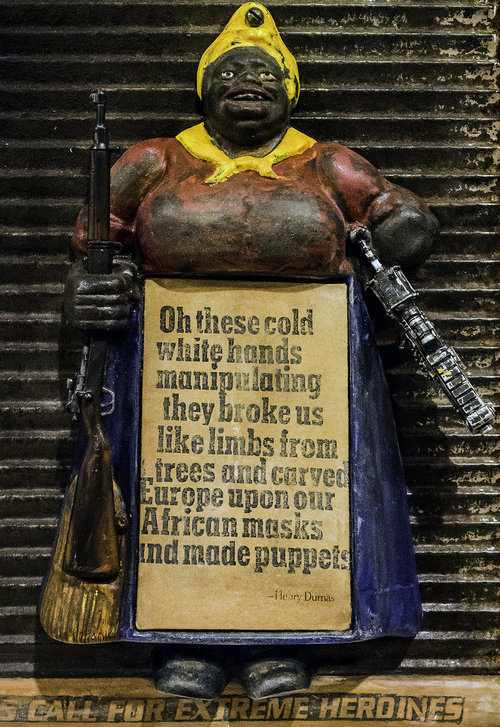Hermeneutic Critique of Leader by Betye Saar
November 29, 2018
by Natalya Mills-Mayrena, Cohort ’16


While investigating the artwork Leader by Saar, it is hard for me as a black woman not to look at it through the hermeneutical lens. It evokes feeling and realities surrounding my identity, cultural and historical. The title in the artwork itself represents a plethora of different ideas for me concerning the black female body in America. Degrading and stereotypical representations of Black women is still an issue that women like myself face daily. This is first why I was drawn to the artwork because not only could I see myself but also my grandmother, mother, and aunts. The image of the woman reminds me very much of my grandmother, not only because of her physical attributes but also because she was a leader in the community and a fighter. She didn’t use guns like the woman in the artwork; instead she used African spirituality and fashion to fight back. She navigated spaces she should have not had access to, but she fought to be there and be accepted.
This artwork also makes me think of the role cinema used to solidify the image placed on African American women, and the way in which it perpetuated stereotypes. Hollywood and cinema played a large role in creating the “Negro Mammy” image in mainstream society. For example, in the 1939 film Gone with the Wind Hattie McDaniel’s character became a staple image in the iconography of the black woman in cinema. Louise Beaver also played the role of the Negro Mammy in many films during the 1920s-1960s, and in the 2011 film The Help both Octavia Butler and Viola Davis played the roles of maids.
The word Leader is juxtaposed against the bar of soap that says Liberate Aunt Jemima; but how can she liberate herself? The Mammy is often depicted as obese, religious, friendly, non-threatening, and often not attractive, and without a husband. Not this Mammy, she was a leader, she had a serious face, she carried guns and was ready for the war for liberation. She would fight for herself and her future generations. The guns in her hands represent the war that black people have been fighting for centuries. For her to be liberated or free herself and for the future she must fight, maybe even start a revolution. I interpret the guns as symbolic for the fight from the past but still present today. The artist’s use of two different styles of guns speaks to the past and the present. In one hand she carries a more contemporary automatic machine gun and in the other hand a wooden and metal shotgun. The words on her skirt speaks clearly to how the artist wants us to understand the realities of this Negro Mammy: “Oh these cold white hands manipulating they broke us like limbs from trees and carved Europe upon our African masks and made puppets”-Henry Dumas. She carries these words with her and so have her ancestors, but she refused to continue that pattern. You will free her willingly or by force, it is now time for liberation, the Liberation of Aunt Jemima. The absence of time also speaks to the continuation of the suppression that takes places in America. It has affected so many black people over a large expanse of time that time no longer matters.
At the bottom of the artwork, on the piece of wood on which she stands, we read, “Extreme Times Call for Extreme Heroines”. This is a very loaded statement not only for black women but women as a whole. In the time of Aunt Jemima, extreme measures were necessary, and extreme measures are still necessary today. This artwork by Betye Saar is not only thought provoking but inspiring. It is a reminder of the work that still needs to be done, not only for our generation and the future generations. I hope that artworks like these continue to inspire and create awareness. Awareness is the only way a society can become conscious of itself, which will then begin to start the healing process and liberation.
